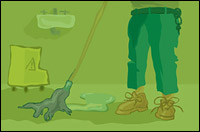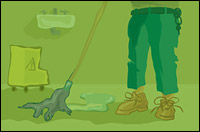Three years ago, the National Geographic Society’s director of general services wanted to clean up his cleaning operations. Bob Cline launched an investigation into the impacts of maintaining the society’s facilities, examining everything from the chemical composition of cleaning products to the decibel level of vacuums, from filtration systems to fuels.

Mess is more.
“Basically, it was a matter of goal congruency,” Cline says. “Conservation is part of the National Geographic Society mission, and we felt that it would be good if our facilities matched our vision.” As he discovered, cleaning up can be a dirty business.
Consider this: Institutional cleaning uses some 6 billion pounds of formulated chemicals a year, according to consultant Stephen Ashkin. Commercial buildings also use 4.5 billion pounds of hand towels and toilet tissue, much of it chlorine-bleached and from virgin pulp, and some 35 billion plastic trash bags a year.
But all that’s changing. Green cleaning — using products and processes that reduce the environmental and health effects of housekeeping on both the indoor and outdoor environments — is catching on in companies, schools, and government agencies, thanks to some powerful players.
Mop Goes the World
It wasn’t always this way. In the beginning — that is, about a decade ago — green cleaning wasn’t an attractive proposition. The products were often expensive, hard to find, and required extra elbow grease. Many of them didn’t even work all that well. For years, green cleaning seemed, well, washed up.
Today, dozens of mainstream companies, from 3M to Johnson Wax, make quality green cleaning products for businesses and institutions, and many of the largest janitorial firms now offer green cleaning services that use these products, often at costs comparable to their conventional counterparts.
What’s changed? One big influence is the U.S. Green Building Council’s LEED rating system. Its LEED-EB standard, which certifies existing buildings, gives “as many as 14 points for the use of green cleaning processes and materials,” says Ashkin, whose Ashkin Group advises the cleaning industry on environmental practices. Since it takes only 32 points to receive the basic level of LEED-EB certification, cleaning and maintenance loom large. That explains why the four largest U.S. janitorial companies — ABM, Aramark, OneSource, and Unicco — have become USGBC members in recent years, Ashkin says.
Another big influence is Green Seal, an organization that issues environmental certification standards for a variety of items — including GS-37, for industrial and institutional cleaning products. More than 50 companies now offer GS-37 certified products. This standard has been recommended by the federal government for its buildings, and many local governments and companies have followed suit. And where these big buyers go, manufacturers follow.
Finally, there’s the health case for greener cleaning. It dates to the early 1990s, when studies showed that improved practices could greatly reduce dust, bacteria, fungi, and volatile organic compounds (VOCs), with concomitant reductions in illness and absenteeism. According to a study by Air Quality Sciences that measured air quality in hundreds of American offices, schools, and homes, VOC levels were as much as 36 times the acceptable level within two hours after cleaning. That can lead to a range of symptoms, from allergies and colds to asthma and respiratory infections. Nearly 12 percent of work-related asthma comes from cleaning products, according to the Harvard Green Campus Initiative. (Harvard is in the process of switching to green cleaning systems in its undergrad dorms.)
“Scientific studies are beginning to document what we in the cleaning industry have believed for years,” says Ashkin. “Cleaning is not merely an expense used to keep floors looking shiny and minimize the number of complaints relating to the lack of toilet paper in the restroom. Rather, it plays an incredibly important role in supporting the work of the organization’s most important asset — its people.”
Good Night, Sweep Tight
All of this — the improved products, the growth of professional green-cleaning services, the potential health improvements — can help you make the business case for greening your company’s janitorial and maintenance operations.
First, determine who’s in charge — that is, where cleaning “lives” in your organization. It might be within the facility department or with the property manager or office manager, among other places. The point is, someone in your organization is responsible for cleaning, or hiring someone to do it.
Then you’ll need to ask questions. “Talk to the janitorial manager or site manager and ask what they’re doing,” counsels Ashkin. “Find out what they know about green cleaning. Get a little background.” (See his newsletter for suggested questions.) You might even consider simply asking the janitorial staff who determines what products they use. That could lead you to the decision-makers.
Be prepared for pushback from within: “There’s nothing we can do until it’s time to renew the contract” (not true; many cleaning firms will adopt greener practices without needing a new contract); “We can’t afford it” (it shouldn’t cost more, and might even cost less); “We’ll have to retrain our cleaning staff” (unlikely; but even if that’s the case, most custodians are willing to learn new tricks).
To help make a convincing case, you may need to offer some guidance. In order to make changes, National Geographic’s Cline helped Unicco, the facility-management firm he was using, determine that they could switch to greener products and practices at no additional cost. The evidence was so compelling, says Cline, that Unicco has since launched its own green-cleaning service.
As Cline reduced the environmental impacts of janitorial services, he noticed other benefits. “One of the things I heard from our cleaning contractor was that there was a big difference on the health of the staff,” he says. And the benefits aren’t limited just to physical health: When the city of Santa Monica, Calif., replaced its traditional cleaning products with less-toxic or nontoxic alternatives, it increased the morale of custodians who recognized the city’s concern for their working conditions, according to Ashkin.
As Cline says, “If someone came to me and made me aware that we could achieve the same level of cleaning but with products that were much less harmful to employees, personnel, and the environment, and at no extra cost, then I’d definitely look into it.”
So get to work on the powers that be — don’t let them sweep this issue under the rug.
For more links and tools, check out GreenBiz.com’s Green Cleaning Resources.



